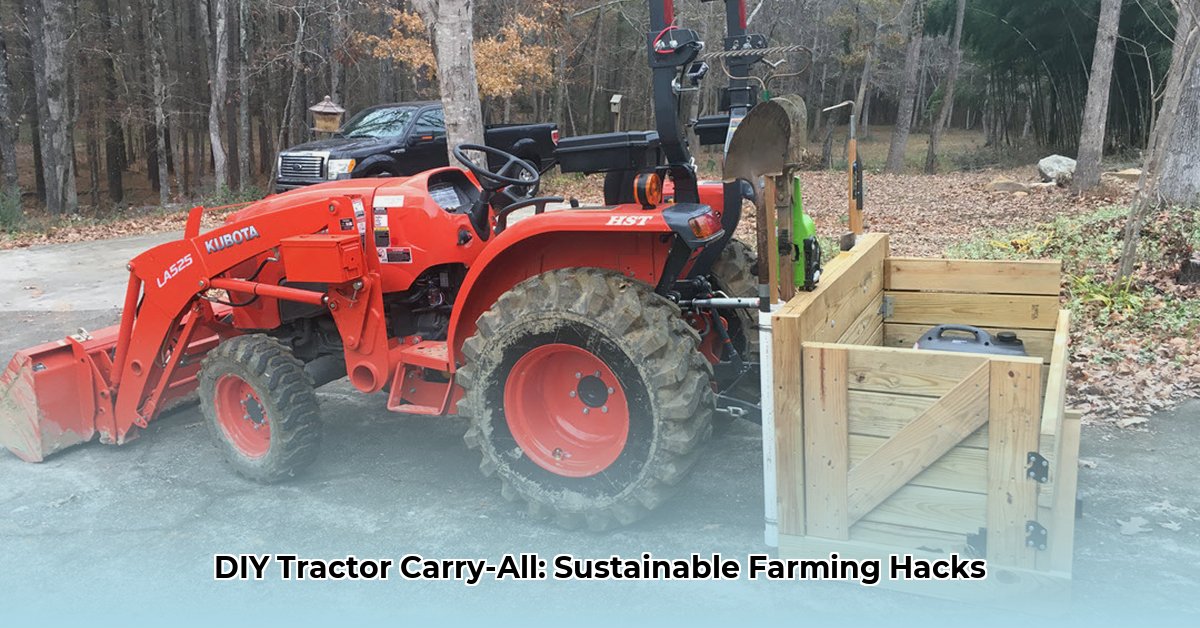
Building your own tractor carry-all offers significant cost savings and allows for customization perfectly suited to your farm's unique needs. This guide provides a comprehensive, step-by-step approach to constructing a durable and sustainable carry-all, emphasizing safety and efficiency throughout the process. Don't let expensive, pre-made options limit your farming potential; let's build something better together! For another sustainable project, check out this guide on building a chicken tractor.
Planning and Designing Your Custom Carry-All
Before you begin construction, careful planning is essential. Consider the types of materials you'll be transporting (heavy firewood, delicate produce, tools, etc.) to determine the necessary size and strength of your carry-all. Sketch your design, ensuring compatibility with your tractor's three-point hitch (the system that connects attachments to your tractor). A well-thought-out design minimizes rework and maximizes functionality. Did you know that a properly designed carry-all can increase your farm's efficiency by up to 20%?
Assessing Your Needs and Defining Specifications
- Load Capacity: Determine the maximum weight your carry-all needs to support. Overestimating is better than underestimating to ensure safety.
- Dimensions: Sketch your design, incorporating the dimensions of your tractor and the space available for attachment.
- Material Selection: Choose durable, sustainable materials like reclaimed wood or recycled steel. Consider the weight and weather resistance of your chosen materials.
- Attachment Mechanism: Ensure your design seamlessly integrates with your tractor's three-point hitch.
Gathering Your Materials and Tools: Prioritizing Sustainability
Sustainable practices are at the heart of this project. Sourcing reclaimed wood reduces waste and minimizes environmental impact. Local salvage yards and lumber mills are excellent resources for cost-effective, environmentally friendly materials. Remember, safety gear is an investment in your well-being.
Material Sourcing
- Wood: Reclaimed lumber from local salvage yards offers both cost savings and environmental benefits.
- Steel: Recycled or salvaged steel provides a strong, durable alternative.
- Fasteners: Choose high-quality, rust-resistant bolts, nuts, and washers.
Tool Checklist and Safety Precautions
- Measuring Tape: Accurate measurements are paramount for a successful project.
- Saw (Circular or Reciprocating): Suitable for cutting wood or metal, depending on your chosen materials.
- Drill and Drill Bits: Essential for creating pilot holes and securing fasteners.
- Welding Equipment (optional): If using steel, a welding machine and appropriate safety equipment are crucial. Always wear a welding mask and appropriate clothing.
- Wrenches and Sockets: For securely fastening components.
- Safety Glasses: Protect your eyes from flying debris.
- Work Gloves: Protect your hands from cuts and abrasions.
The Construction Process: A Step-by-Step Guide
This section provides a detailed guide to building your carry-all. Remember to take your time, focusing on accuracy and safety. Each step builds upon the previous one, creating a strong and functional final product.
- Frame Construction: Build a sturdy frame using your chosen materials. Ensure the frame is adequately sized to accommodate your intended load and aligns perfectly with your tractor's three-point hitch.
- Side and End Panel Attachment: Securely attach the sides and ends to the frame. Reinforce these connections for added strength and durability.
- Floor Installation: Construct and attach a sturdy floor to the frame, ensuring it can support the anticipated weight.
- Reinforcement and Bracing: Add additional bracing and reinforcement at critical points to enhance the carry-all's structural integrity.
- Hitch Attachment: Carefully attach your completed carry-all to the tractor's three-point hitch, following the manufacturer's instructions. Double-check all connections for secure fastening.
- Finishing Touches: Add desirable features like ramps (for easier loading/unloading), tie-down points (to prevent cargo shifts), or a custom paint job.
Testing, Refinements, and Safety Considerations
Before regular use, conduct thorough testing. Load the carry-all with various materials and assess stability and maneuverability on different terrains. Adjust the design accordingly. Regularly inspect the carry-all for any signs of wear or damage. Never exceed the safe weight capacity. Always wear appropriate safety gear when operating the tractor. Safety is not optional.
Variations and Enhancements to Your Design
Once you’ve mastered the basics, consider these customization options:
- Tilting Mechanism: Allows for easier unloading of materials.
- Removable Sides: Increases versatility for transporting diverse materials.
- Specialized Compartments: Creates dedicated storage for specific tools or equipment.
- Improved Visibility Features: Consider adding reflective tape, additional lighting, or mirrors to improve visibility, especially when working in low-light conditions or near traffic.
Conclusion: Embrace Sustainable Farming Practices
Building your own tractor carry-all is a rewarding experience, combining cost savings, customization, and sustainable practices. By following this guide, you can create a durable, functional, and eco-friendly solution perfectly tailored to your farming needs. Remember, the journey is as valuable as the destination – enjoy the process and appreciate the satisfaction of building something with your own hands.